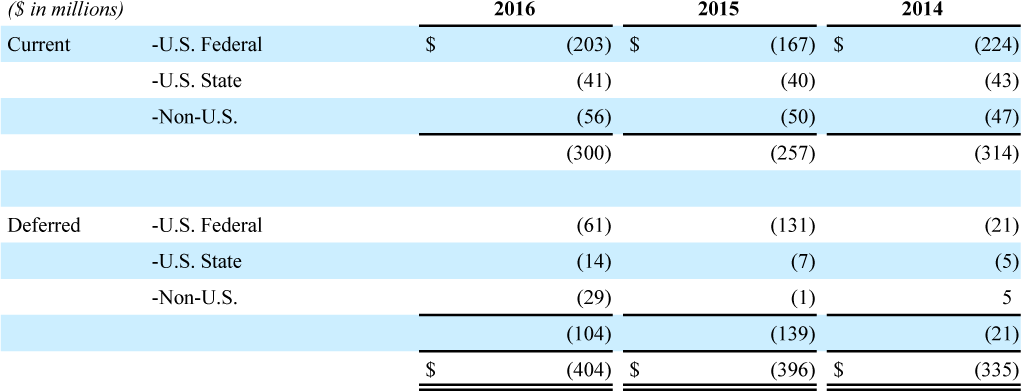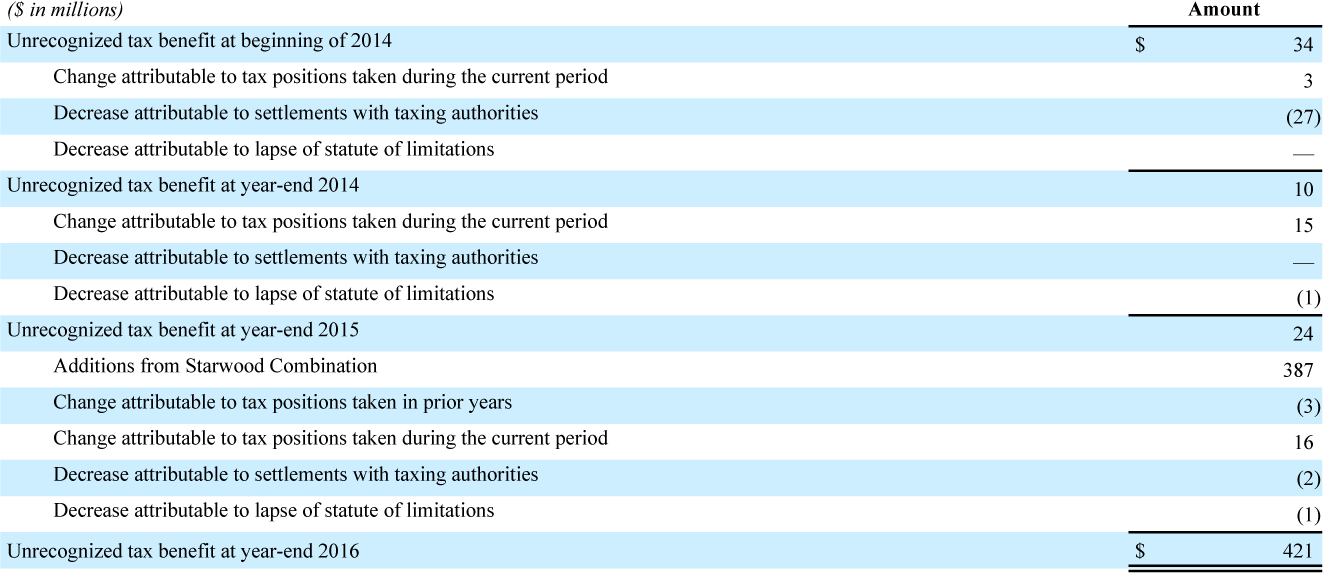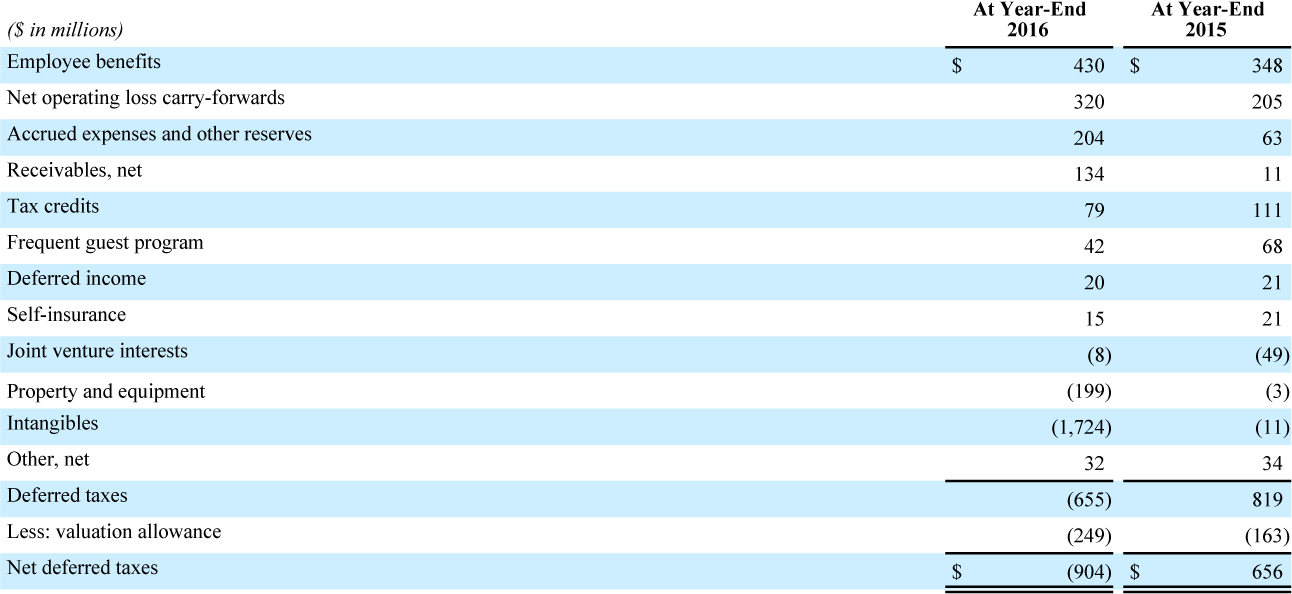Financial Information
Jump to a Section:
PART II
Item 8. Financial Statements and Supplementary Data.
MARRIOTT INTERNATIONAL, INC.
NOTES TO CONSOLIDATED FINANCIAL STATEMENTS
7. INCOME TAXES
The components of our earnings before income taxes for the last three fiscal years consisted of:

Our provision for income taxes for the last three fiscal years consists of:

Our current tax provision does not reflect the following benefits attributable to us for the vesting or exercise of employee share-based awards: $32 million in 2016, $34 million in 2015, and $89 million in 2014. The preceding table includes tax credits of $4 million in 2016, $4 million in 2015, and $4 million in 2014. We had tax applicable to other comprehensive income of $3 million in 2016, $2 million in 2015, and $5 million in 2014.
We have made no provision for U.S. income taxes or additional non-U.S. taxes on the cumulative unremitted earnings of non-U.S. subsidiaries ($3,950 million as of year-end 2016). We consider the earnings for substantially all non-U.S. subsidiaries to be indefinitely reinvested. These earnings could become subject to additional taxes if the non-U.S. subsidiaries dividend or loan those earnings to a U.S. affiliate or if we sell our interests in the non-U.S. subsidiaries. We cannot practically estimate the amount of additional taxes that might be payable on the unremitted earnings.
Unrecognized Tax Benefits
The following table reconciles our unrecognized tax benefit balance for each year from the beginning of 2014 to the end of 2016:

These unrecognized tax benefits reflect the following year-over-year changes: (1) a $397 million increase in 2016, largely attributable to Legacy-Starwood unrecognized tax benefits assumed in the Starwood Combination; (2) a $14 million increase in 2015, largely attributable to a U.S. federal tax issue regarding transfer pricing; and (3) a $24 million decrease in 2014, largely attributable to the favorable settlements reached with taxing authorities on both federal and international positions taken in prior years.
Our unrecognized tax benefit balances included $288 million at year-end 2016, $15 million at year-end 2015, and $7 million at year-end 2014 of tax positions that, if recognized, would impact our effective tax rate. It is reasonably possible that we will settle $73 million of unrecognized tax benefits within the next twelve months. This includes $59 million of U.S. federal issues that are currently in appeals, $11 million of state and non-U.S. audits expected to be resolved in 2017, and $3 million related to issues for which statutes of limitations will expire in 2017. We recognize accrued interest and penalties for our unrecognized tax benefits as a component of tax expense. Related interest totaled $8 million in 2016, $3 million in 2015, and $2 million in 2014.
We file income tax returns, including returns for our subsidiaries, in various jurisdictions around the world. The U.S. Internal Revenue Service (“IRS”) has examined our federal income tax returns, and we have settled all issues for tax years through 2013 for Marriott and through 2006 for Starwood. Our Marriott 2014 and 2015 tax year audits are substantially complete, and our Marriott 2016 tax year audit is currently ongoing. Starwood is currently under audit by the IRS for years 2010 through 2012 and in appeals for years 2007 through 2009. Various foreign, state, and local income tax returns are also under examination by the applicable taxing authorities.
Deferred Income Taxes
Deferred income tax balances reflect the effects of temporary differences between the carrying amounts of assets and liabilities and their tax bases, as well as from net operating loss and tax credit carry-forwards. We state those balances at the enacted tax rates we expect will be in effect when we actually pay or recover the taxes. Deferred income tax assets represent amounts available to reduce income taxes we will pay on taxable income in future years. We evaluate our ability to realize these future tax deductions and credits by assessing whether we expect to have sufficient future taxable income from all sources, including reversal of taxable temporary differences, forecasted operating earnings, and available tax planning strategies to utilize these future deductions and credits. We establish a valuation allowance when we no longer consider it more likely than not that a deferred tax asset will be realized.
The following table presents the tax effect of each type of temporary difference and carry-forward that gave rise to a significant portion of our deferred tax assets and liabilities as of year-end 2016 and year-end 2015:

During 2016, the valuation allowance increased primarily due to the Starwood Combination. The valuation allowance is attributable to non-U.S. and U.S. state net operating loss carry forwards.
At year-end 2016, we had approximately $65 million of tax credits that expire through 2036 and $13 million of tax credits that do not expire. We recorded $5 million of net operating loss benefits in 2016 and $5 million in 2015. At year-end 2016, we had approximately $2,152 million of primarily state and foreign net operating losses, of which $1,243 million expire through 2036.
Reconciliation of U.S. Federal Statutory Income Tax Rate to Actual Income Tax Rate
The following table reconciles the U.S. statutory tax rate to our effective income tax rate for the last three fiscal years:

(1) Includes differences between U.S. and foreign statutory rates as well as tax incentives and tax-exempt income from operations in certain foreign jurisdictions, which we consider to be equivalent to a reduction of the statutory tax rates in these jurisdictions.
We paid cash for income taxes, net of refunds of $293 million in 2016, $218 million in 2015, and $172 million in 2014.